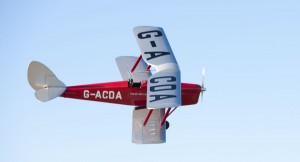The Hangar 9 Tiger Moth maintains all the great qualities of its full-size counterpart that made that aircraft such a success back in the 1930’s.
Designed to enable pilots to assemble and fly a scale biplane with the minimum of fuss and bother the Tiger Moth is the perfect model with which to emulate flying from the “Golden Era” of aviation.
No compromise has been made on the scale outline and the wings feature the correct under cambered airfoil, which is the basis for the models incredible slow flight characteristics.
Traditional balsa and plywood construction features throughout and this is covered with Ultracote in a scale Red and Silver colour scheme representing G-ACDA of the De-Havilland Flying School.
Other features include a pre-painted fibreglass cowl, pre-formed rigging wires, full instrument panels, scale wheels and “DH” hub caps, pre-formed cabane and inter-plane struts, working suspension landing gear and tail wheel.
With this amount of pre-fabrication quick assembly follows and you can be flying in your first scale competition in no time.
Given the accurate scale nature of this plane, it is only fitting that it flies with the same gentle characteristics as its full-scale counterpart. This makes it a great first giant scale plane for pilots looking to fly a handsome looking scale biplane that is just perfect for those lazy afternoon flights!
* Full instrument panels pre-installed
* Under cambered airfoil for excellent slow flight
* Scale rigging wires for added realism
* Highly accurate scale replica with exact scale outline
* Suitable for scale competition
* Perfect as a first scale biplane.
* Pre-hinged control surfaces for ease of assembly
* Covered in Ultracote in a scale 1930’s colour scheme
* Wing transport jigs for easy assemble and transport
* Pre-fabricated components make the plane easier to build
* Gentle flying characteristics and high stability
Wingspan 2.2m (88” inch)
Overall Length 1.8m (72 inch)
Wing Area 148 sq dm (2290 sq inch)
Flying Weight 6.8 – 7.1kg (15 – 15.5 lbs)
Engine Size 2-stroke petrol 26cc Four Stroke 30cc
Colour scheme Red and Silver
Spinner Size 2.5inch
Radio 4-channel with 6 servos
Recommended Engine
Engine Evolution 26GX 2-stroke (EVOE40GX)
Exhaust Recommended Evolution muffler EVO30943402
De Havilland DH 82 Tiger Moth
The de Havilland DH 82 Tiger Moth is a 1930s two-seat biplane designed by Geoffrey de Havilland. The DH.82 attracted the interest of the Royal Air Force, and the first of what would ultimately be several thousand Tiger Moths entered service with the RAF in 1932.
Operated by the Royal Air Force and other nations air forces as a standard basic pilot training aircraft, production of the Tiger Moth increased greatly during WW2, and some 4000 were built in the UK.
During the war large numbers were also built in Canada (as the DH.82C with a Gipsy Major IC or 120kW/160hp Pirate D.4 engine), Australia and New Zealand.
The Tiger Moth remained in service with the RAF until 1952 when many of the surplus aircraft entered civil operation. Many other nations used the Tiger Moth both in military and civil applications and today this famous and much loved “stick and fabric” little biplane trainer is still in great demand worldwide by those pilots looking once again for that silk scarf blowing in the wind experience!
An interesting note for modellers perhaps is the fact that the full-size Tiger Moth was first flown by radio control over 70 years ago!
Called the Queen Bee it was a modification of the highly successful and reliable DH82A “Tiger Moth”. Queen Bees were first produced in 1935 in response to an Air Ministry request for an inexpensive, expendable radio-controlled target drone for anti-aircraft gunnery practice.
The front cockpit was fitted with conventional controls for a test pilot or ferry pilot, while the rear carried the radio control receiver and pneumatically operated servos for the flying controls. It is said to be the first full-size aircraft originally designed to fly unmanned and under radio control.
A total of about 400 were built, mainly at Hatfield, England and most were destroyed, suffering the fate for which they were built.
Source: Horizon Hobby UK





